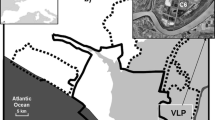Abstract
In contrast to other eutrophic shallow lakes in the Scharmützelsee region, a delayed onset of the phytoplankton succession in Lake Melangsee during spring was regularly observed. Biomasses were opposed to the carrying capacity of the lake (calculated from total-P, total-N and underwater light), indicating further regulating factors in spring. This phase was characterised by high Secchi depths, rising flushing and enhanced oxygen concentrations at the lake bottom. Although silicate concentrations decreased in spring, a typical pelagic diatom or cyanobacterial bloom did not develop. Therefore, we frame the hypothesis that a combination of abiotic factors such as increased losses in spring due to higher flushing and a better light supply suppresses pelagic growth and favours benthic diatoms, which outcompete pelagic diatoms for silicate. The vertical oxygen distribution in this period indicates a shift from pelagic primary production to benthic growth. Considering primary production, flushing, under water light supply and nutrients we tried to find the reasons for the depression of phytoplankton growth during spring.
Similar content being viewed by others
References
Behrendt, H. & B. Nixdorf, 1993. The carbon balance of phytoplankton production and loss processes based on in situ measurements in a shallow lake. Int. Rev. ges. Hydrobiol. 78: 439–458.
Deneke, R. & B. Nixdorf. On the occurrence of clear water phases on relation to shallowness and trophic state. Hydrobiologia 408/409: 251–262.
Deutsche Einheitsverfahren zur Wasser-, Abwasser-und Schlammuntersuchung, 1986–1998. Verlag Chemie GmbH Weinheim.
Foy, R. H., Gibson, C. E. & R. V. Smith, 1976. The influence of daylength, light intensity and temperature on the growth rates of planktonic blue-green algae. Br. Phycol. J. 11: 151–163.
Huszar, V. L & C. S. Reynolds, 1997. Phytoplankton periodicity and sequences of dominance in an Amazonian flood-plain lake (Lago Batata, Pará, Brazil): responses to gradual environmental change. Hydrobiologia 346: 169–181.
Köhler, J., H. Behrendt & S. Hoeg. Long-term response of phytoplankton to reduced nutrient load in the flushed lake Müggelsee (Spree system, Germany). Arch. Hydrobiol. (in press).
Nicklisch, A. & J. G. Kohl, 1989. The influence of light on the primary production of two planktic blue-green algae. Arch. Hydrobiol. Beih. 33, 451–455.
Nixdorf, B., 1994. Polymixis of a shallow lake (Großer Müggelsee, Berlin) and its influence on seasonal phytoplankton dynamics. Hydrobiologia 275/276: 173–186.
Nixdorf, B. & R. Deneke, 1997. Why ‘very shallow’ lakes are more successful opposing reduced nutrient loads. Hydrobiologia 342/343: 269–284.
Reynolds, C. S., 1984. The ecology of freshwater phytoplankton. Cambridge Univ. Press: 384 pp.
Reynolds, C. S. & J. W. G. Lund, 1988. The phytoplankton of an enriched, soft-water lake subject to intermittent hydraulic flushing (Grasmere, English Lake District). Freshwat. Biol. 19: 379–404.
Reynolds, C. S., 1997. Vegetation Processes in the Pelagic: A Model for Ecosystem Theory. Excellence in Ecology, 9; Ecology Institute Oldendorf, Germany: 371 pp.
Rücker, J., 1998. Chlorophyll, Phytoplanktonentwicklung und Primärproduktion im Scharmützelsee 1993–1997. In Schmitt, M. & Nixdorf, B. (eds), Gewässerreport Nr. 4, BTUC-AR: 5/98: 70–81.
Scheffer, M., 1998: Ecology of shallow lakes. Chapman & Hall, London: 346 pp.
Sommer, U., Z. M. Gliwicz, W. Lampert & A. Duncan, 1986. The PEG-model of seasonal succession in planktonic events in fresh waters. Arch. Hydrobiol. 106: 433–471.
Sommer, U., 1991. The application of the droop-model of nutrient limitation to natural phytoplankton. Verh. int. Ver. Limnol. 24: 791–794.
Sommer, U., 1993. Disturbance-diversity relationships in two lakes of similar nutrient chemistry but contrasting disturbance regimes. Hydrobiologia 249: 59–65.
Tilzer, M. M., 1984. Estimation of phytoplankton loss rates from daily photosynthetic rates and observed biomass changes in Lake Constance. J. Plankton Res. 6: 309–323.
Utermöhl, H., 1958. Zur Vervollkommnung der quantitativen Phytoplanktonmethodik. Mitt. int. Ver. Limnol. 9: 1–38.
Van Liere, L. & L. R. Mur, 1980. Occurrence of Oscillatoria agardhiiand some related species, a survey. In Barica, J. & L. R. Mur (eds), Hypertrophic Ecosystems. Dr. W. Junk Publ., The Hague: 67–77.
Vollenweider, R. A. (ed.), 1974. A manual on methods for measuring primary production in aquatic environments. IBP Handbook Vol. 12. Blackwell Sci. Publ., Publ., Oxford: 225 pp.
Author information
Authors and Affiliations
Corresponding author
Rights and permissions
About this article
Cite this article
Schmitt, M., Nixdorf, B. Spring phytoplankton dynamics in a shallow eutrophic lake. Hydrobiologia 408, 269–276 (1999). https://doi.org/10.1023/A:1017096210578
Issue Date:
DOI: https://doi.org/10.1023/A:1017096210578




